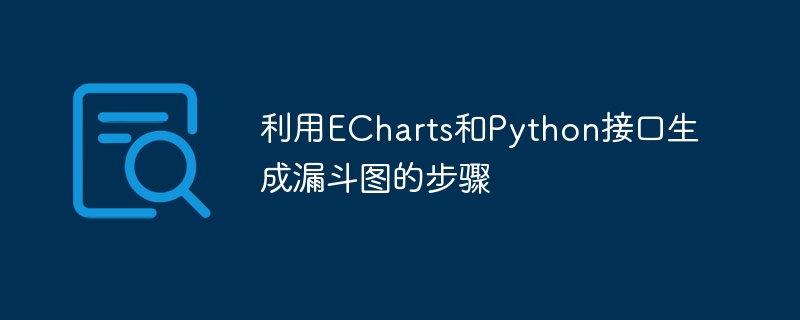

The steps to generate a funnel chart using ECharts and Python interfaces require specific code examples
The funnel chart is a commonly used data visualization tool that can be used to display data in changes between different stages. Using ECharts and Python interface, we can easily generate beautiful funnel charts. Below, we will follow the steps below to introduce how to generate a funnel chart and give specific code examples.
Step 1: Install ECharts and Python interface
First, we need to install ECharts and Python interface and configure the environment. ECharts is a JavaScript-based data visualization library. By introducing ECharts, we can call relevant APIs in Python code to generate funnel charts. There are multiple ECharts interfaces for Python, such as pyecharts, echarts-python, etc. Here we take pyecharts as an example. We install it through the pip command:
pip install pyecharts
Step 2: Import the required libraries
In the Python code, we need to import some necessary libraries in order to process data processing and chart generation. Here we need to import the pyecharts library and other related data processing libraries. The specific code is as follows:
from pyecharts.charts import Funnel from pyecharts import options as opts
Step 3: Prepare data
Before generating the funnel chart, we need to prepare the data. Funnel charts are usually used to represent the transformation of data in different stages, so we need to prepare a stage list and corresponding data list. Taking generating a simple funnel chart as an example, we can define the data like this:
stage = ['访问', '加入购物车', '下单', '支付'] data = [1000, 800, 600, 400]
Step 4: Generate a funnel chart
Next, we can use the Funnel class in the pyecharts library to generate a funnel chart . Before generating a funnel chart, we can set some basic properties of the chart, such as title, legend, etc. The specific code is as follows:
chart = (
Funnel(init_opts=opts.InitOpts(theme='light'))
.set_global_opts(
title_opts=opts.TitleOpts(title='漏斗图示例'),
legend_opts=opts.LegendOpts(is_show=False),
)
.add(
series_name='',
data_pair=list(zip(stage, data)),
gap=2,
tooltip_opts=opts.TooltipOpts(formatter='{b}: {c}'),
label_opts=opts.LabelOpts(is_show=True, position='inside')
)
.set_series_opts(label_opts=opts.LabelOpts(position='inside'))
)
chart.render('funnel.html')In the above code, we created a Funnel object and used the set_global_opts method to set the title and legend of the funnel chart. Next, use the add method to add the data and related settings of the funnel chart. For example, the gap parameter is used to set the spacing between funnel charts, the tooltip_opts parameter is used to set the prompt box style when the mouse is hovering, and the label_opts parameter is used to set the label. Style and location. Finally, use the render method to render the chart into an HTML file.
Step 5: Run the code
Finally, we can run the code and open the generated HTML file in the browser to see the generated funnel chart. The specific code is as follows:
from pyecharts.render import make_snapshot from snapshot_selenium import snapshot as driver options = opts.PrettyJsTurnOffOpts() make_snapshot(driver, chart.render(), "funnel.png", is_remove_html=True, **options)
Before this, you need to install snapshot_selenium and add the path to the system environment variable: pip install snapshot-selenium
The above is to use ECharts and Python interfaces to generate funnels Figure showing all steps and code examples. Through the above steps, we can quickly generate a beautiful funnel chart and visually display the changes in the data. Hope the above content is helpful to you!
The above is the detailed content of Steps to generate funnel chart using ECharts and Python interface. For more information, please follow other related articles on the PHP Chinese website!




